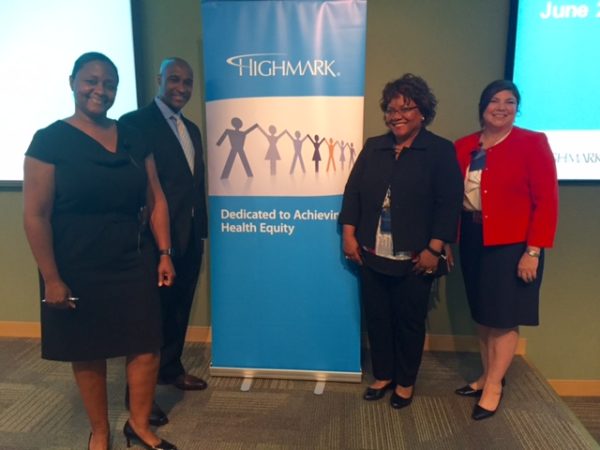Health Equity 360: Listening and Learning at Our Community Forums
- By: Dr. Rhonda Johnson
- Posted: August 30, 2016
 Share This
Share This
Allentown, Camp Hill, Erie and Pittsburgh in Pennsylvania. Bluefield and Charleston in West Virginia. Wilmington in Delaware. These are all locations where, between 2010 and 2016, Highmark Inc.'s health equity and quality services team conducted forums to solicit input from members of our communities.

Andrea Bullock, Paul Pelmon, Dr. Rhonda Johnson and Dr. Oralia Dominic from the Highmark Health Equity and Quality Services Team
We sought guidance from the community in order to evaluate the effectiveness of interventions, including Highmark's own activities, related to eliminating health care disparities.
Their input was very valuable in identifying barriers and root causes of health care disparities and prioritizing opportunities to deliver more culturally and linguistically appropriate care to our members.
Some, but not all, participants were Highmark health plan members, with representation from our clients, faith-based organizations, public health and social service agencies, and other community-based organizations. Physicians, nurses and representatives from medical societies also attended over the years. We welcomed diverse points of view ranging from millennials to seniors; from first-generation and second-generation immigrants to members of the LGBTQ community.
Although these forums touched on many subjects, certain themes came up again and again, and I want to share some of the insights using people's own words.
It's a Matter of Trust
- “People trust who they see. Face-to-face communication is best.” (2010)
- “People believe their friend more than their doctor and men trust their barber.” (2010)
- “Use patient navigators, promotores, doulas, in our community — these folks are trusted sources of information.” (2010)
- “If you work with a trusted community organization, you don't need to build it if you use your community.” (2011)
- “Have print materials, newsletters and other media culture-friendly with appropriate look and literacy level for your targeted community. The appropriate photo will help to establish trust.” (2013)
- “We must build trust. We need to start thinking about creating a foundation of trust.” (2014)
- “HEQS is breaking down trust barriers for Highmark.” (2016)
People Need Help Understanding Their Health Insurance Plans
- “Seniors need more help understanding brochures and forms.” (2011)
- “Work with schools to get health education information out to parents and patients.” (2012)
- “Consider offering something that explains how insurance works. Folks do not understand the process terminology and/or deductibles/copays.” (2013)
- “Consider educating the members with letters on how to communicate with your provider.” (2013)
- “Create a program that would: a). Explain health care benefits; b). Teach the community how to use their benefits; c). Provide resources to help individuals get benefits; d). Offer additional educational opportunities for members and providers to understand health insurance benefits.” (2014)
- “Make sure communications are at a 5th grade reading level, and in appropriate spoken and written languages.” (2015)
- “Lack of insurance information for students in the college settings; students get their first jobs after graduation and do not know anything about selecting health insurance benefits.” (2016)
- “Use creative messages in unique places, such as bus stops.” (2016)
Interpretation Services Are Needed for People With Limited English Proficiency
- “The language line system for interpretation is not effective. Patients prefer a personal interpreter who they know and speak their language.” (2012)
- “Need to train hospital staffs on how to work with interpreters.” (2012)
- “Educate the provider on how to use and/or access interpreters and/or interpretation services.” (2013)
- “Children should not be used as interpreters in the health care setting.” (2016)
Practitioners Need More Training on How to Interact With People From Diverse Backgrounds
- “Please train office staff in addition to doctors.” (2010)
- “Physicians and office staffs do not speak the language of the patients.” (2012)
- “Provide cultural competency training to osteopathic and medical students.” (2013)
- “There is a lack of cultural competency training with physicians. Consider more training for the doctors and medical staff.” (2014)
- “Consider training health care providers, staff and professionals on bedside manners and how to communicate with patients of diverse backgrounds.” (2014)
- “Can Highmark develop a summer program for cultural competence?” (2014)
- “HEQS should use our cultural competency training resources to teach pre-medical and nursing students the importance of valuing diversity and treating all patients with respect.” (2016)
Turning Suggestions Into Actions
Over the years, suggestions like those above have resulted in partnerships, programs and initiatives that have improved specific services to our members. We have developed new health promotion initiatives with community- and faith-based partners, simplified our member communications, and continued to educate our practitioner network on the use of qualified medical interpreters and the importance of culturally respectful health care. We have dispensed hundreds of thousands of health promotional items to our community groups on topics that range from getting the most out of your doctor's visit to condition-specific education in multiple languages. We have mobilized resources that helped to close gaps in care needs identified by the forum participants.
We learned from listening, and then wherever we could, we made changes to help create a better health care experience for all. I believe this is how a health care system should work — and I am proud that the health equity and quality services team carried out that work at Highmark with tremendous passion and effectiveness.
